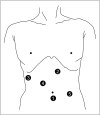Laparoscopic left hemihepatectomy for left intrahepatic duct stones
- PMID: 22977761
- PMCID: PMC3433551
- DOI: 10.4174/jkss.2012.83.3.149
Laparoscopic left hemihepatectomy for left intrahepatic duct stones
Abstract
Purpose: The feasibility of laparoscopic left hemihepatectomy for the management of intrahepatic duct (IHD) stones was evaluated.
Methods: The clinical data of 26 consecutive patients who underwent total laparoscopic left hemihepatectomy for IHD stones at Gyeongsang National University Hospital between January 2009 and June 2011 were reviewed retrospectively.
Results: The mean operation time was 312.1 ± 63.4 minutes and the mean postoperative hospital stay was 11.8 ± 5.0 days. There were 2 cases of postoperative bile leakage and 3 cases of intra-abdominal fluid collection, which were successfully managed conservatively. Remnant stones were detected in 2 patients. The initial success rate of stone clearance was 92.3% (24 of 26). The remnant stones were located in the common bile duct in both cases and were removed by endoscopic retrograde cholangiopancreatography and endoscopic sphincterotomy. Therefore, the final success rate of stone clearance was 100% (26 of 26). During a mean follow-up of 22 months (range, 7 to 36 months), there was no patient with recurrent stone.
Conclusion: Laparoscopic surgery could be an effective treatment modality for the management of IHD stones in select patients.
Keywords: Hepatectomy; Laparoscopy.
Conflict of interest statement
No potential conflict of interest relevant to this article was reported.
Figures


Similar articles
-
Comparison of laparoscopic versus open left-sided hepatectomy for intrahepatic duct stones.Surg Endosc. 2016 Jan;30(1):259-65. doi: 10.1007/s00464-015-4200-3. Epub 2015 Apr 11. Surg Endosc. 2016. PMID: 25861904
-
Laparoscopic treatment for intrahepatic duct stones in the era of laparoscopy: laparoscopic intrahepatic duct exploration and laparoscopic hepatectomy.Ann Surg. 2009 Feb;249(2):286-91. doi: 10.1097/SLA.0b013e31818eea56. Ann Surg. 2009. PMID: 19212183
-
Laparoscopic Left Hemihepatectomy for Left-sided Hepatolithiasis.Surg Laparosc Endosc Percutan Tech. 2015 Aug;25(4):347-50. doi: 10.1097/SLE.0000000000000173. Surg Laparosc Endosc Percutan Tech. 2015. PMID: 26121543
-
[Management of Intrahepatic Duct Stone].Korean J Gastroenterol. 2018 May 25;71(5):247-252. doi: 10.4166/kjg.2018.71.5.247. Korean J Gastroenterol. 2018. PMID: 29791982 Review. Korean.
-
["Sequential" treatment: is it the best alternative in cholecysto-choledochal lithiasis?].Chir Ital. 2002 Nov-Dec;54(6):785-98. Chir Ital. 2002. PMID: 12613326 Review. Italian.
Cited by
-
Development and Validation of a Difficulty Scoring System for Laparoscopic Liver Resection to Treat Hepatolithiasis.Medicina (Kaunas). 2022 Dec 15;58(12):1847. doi: 10.3390/medicina58121847. Medicina (Kaunas). 2022. PMID: 36557049 Free PMC article.
-
Validation of difficulty scoring system for laparoscopic liver resection in patients who underwent laparoscopic left lateral sectionectomy.Surg Endosc. 2017 Jan;31(1):430-436. doi: 10.1007/s00464-016-4994-7. Epub 2016 Jun 10. Surg Endosc. 2017. PMID: 27287898
References
-
- Huang MH, Chen CH, Yang JC, Yang CC, Yeh YH, Chou DA, et al. Long-term outcome of percutaneous transhepatic cholangioscopic lithotomy for hepatolithiasis. Am J Gastroenterol. 2003;98:2655–2662. - PubMed
-
- Lee SK, Seo DW, Myung SJ, Park ET, Lim BC, Kim HJ, et al. Percutaneous transhepatic cholangioscopic treatment for hepatolithiasis: an evaluation of long-term results and risk factors for recurrence. Gastrointest Endosc. 2001;53:318–323. - PubMed
-
- Jan YY, Chen MF, Wang CS, Jeng LB, Hwang TL, Chen SC. Surgical treatment of hepatolithiasis: long-term results. Surgery. 1996;120:509–514. - PubMed
-
- Cheung MT, Kwok PC. Liver resection for intrahepatic stones. Arch Surg. 2005;140:993–997. - PubMed
-
- Han HS, Yi NJ. Laparoscopic treatment of intrahepatic duct stone. Surg Laparosc Endosc Percutan Tech. 2004;14:157–162. - PubMed
LinkOut - more resources
Full Text Sources

